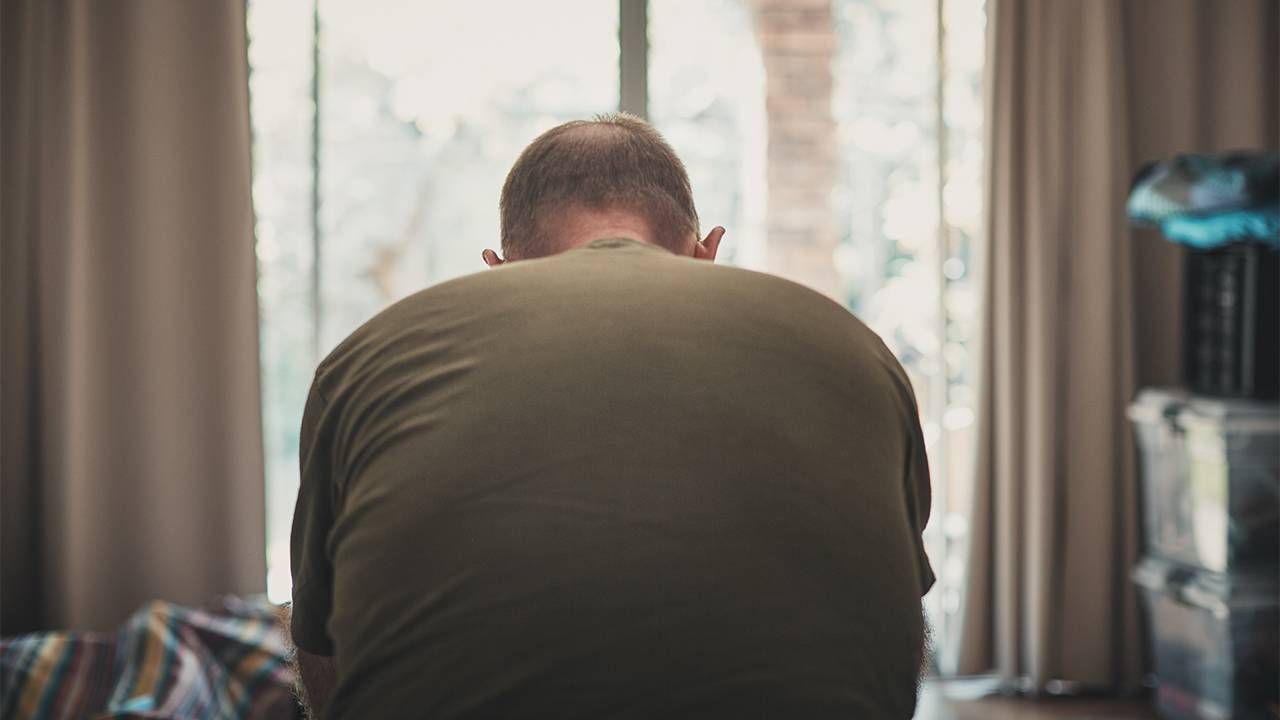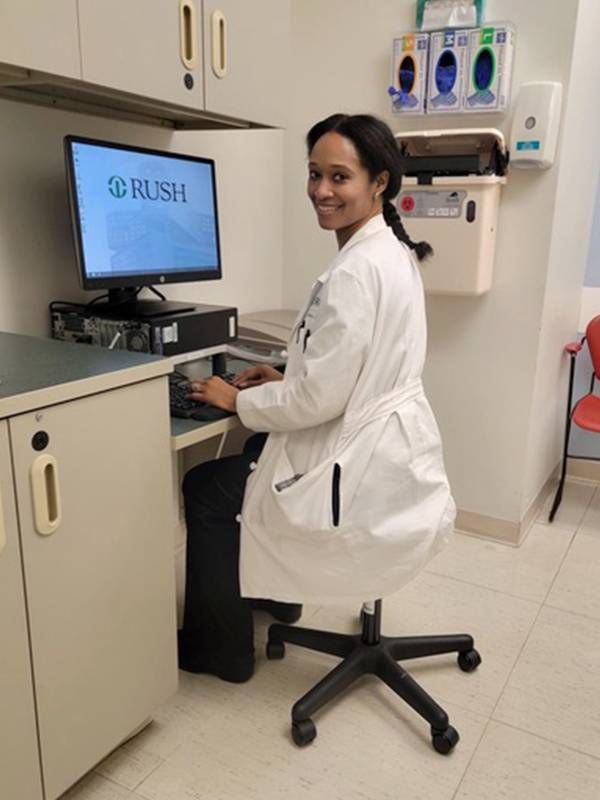Why Good Posture Matters No Matter Your Age
Even before 'pandemic posture' was a thing, people have been struggling to stay upright. The causes are many, but we break down what you can do to improve your posture.
Elaine Geha loves playing tennis, taking long walks and gardening. What the 74-year-old Enfield, Conn., resident did not love was the neck pain, headaches and stiff neck that made it difficult to function during the day and sleep at night for months. Geha eventually discovered the cause of her aches and pains after going to physical therapy.

"I've been told by my physical therapist that the tension in my neck is related to poor posture," the retired office manager says. "I'm putting my head forward and putting pressure on my neck…I never thought about posture before, but now I'm more aware of it."
Standing up straighter and doing PT (physical therapy) exercises have helped. As she talks on the deck of her home, she demonstrates an exercise: One hand is on each end of a green elastic resistance band that she stretches and releases in front of her chest. She does 10 reps, three times, at least once a day.
"Good posture can decrease the incidence of low back and neck pain."
"This is so great. You can do it anywhere," she says while holding her TheraBand. The exercise, known as scapular retraction, was strengthening her rhomboids, the back muscles that support the scapula.
Laurie Ulster, 55, a freelance writer in New York City, says poor posture led to a bone spur in her neck that required months of physical therapy. It came from working at less-than-optimal setups around her house: a desk at the wrong height or a table in the living room and occasionally on the couch with the computer on the coffee table.
She upgraded to a good chair with armrests, a footrest, and a lap desk that adjusts to the right height.
"I knew what hurt and played with different positions to see what was right," Ulster says. "It solved my arm problem and my neck problem." Doing daily shoulder blade squeezes also helps.
Don't Be a Slouch
Whether it's from standing or sitting with bad posture, years of slouching can make your spine more fragile and injury prone, experts say. But don't panic! If you are among the already hunched over, there are things you can do. And if you have good posture, there are ways to maintain it.
"When you're standing with good posture, your head is on top of your body in alignment with your spine — not leaning forward or right or left," says Dr. Laura Deon, a physical medicine and rehabilitation specialist at Rush University Medical Center in Chicago. "Good posture can decrease the incidence of low back and neck pain, decrease abnormal wear and stress on your joint surfaces and decrease shoulder and neck tension."
Your Job May Be Hurting Your Back
What causes poor posture? Having a job where you sit for long periods of time, for starters, Deon says. "(Those with) sedentary occupations and those who drive for a living are subject to postural stress and poor postures which can lead to back, neck and upper extremity pain," she says.

Austin Martinez, a certified athletic trainer in Irvine, Calif., puts it this way: "When your head moves forward, you're out of alignment and that puts stress on your body."
Something else: "Our technology is getting smaller," notes Alessa Caridi, a Pilates instructor who runs a New York-City-based workplace wellness program. "We're leaning in, our hands are getting closer to our body…It doesn't matter what you do during the day. Your posture comes into play in all aspects of your life. If you are slouched in one direction, that slouch becomes bigger and our muscles deteriorate."
And with more people working from home and ailing from so-called "Zoom neck" — a relative of "tech neck" — the World Economic Forum listed "bad backs through poor ergonomic posture" as one of the long-terms risks of COVID-19.
A Common Condition
Osteoporosis, which is four times more common in women than in men, is another risk factor.
"Osteoporosis makes the spine bones softer, which can cause compression fractures and compression deformities (wedging) of the vertebral bodies, which means that the front part of the bone is shorter than the back part. This can cause increased thoracic kyphosis (forward hump or curve of the midback)," Dr. Ai Mukai, a physical medicine and rehabilitation physician at Texas Orthopedics, said in an email.
Tips, Tricks and Hacks
You might be surprised at some of the other consequences of poor posture.
They include poor balance, headaches, breathing difficulties, possibly even poor digestion and incontinence, as well as "mood, sleep, fatigue and jaw alignment," according to physical therapist Meghan Markowski, quoted in an article about the risks of poor posture in Harvard Health Publishing.
But there are things you can do.
When it comes to your job: "Consider a sit/stand desk or adjusting your chair/monitor/desk height to make sure that your work station is ergonomic," she says. "A comfortable work station means better posture, less pain, and more energy." (Check out these OSHA guidelines for proper monitor height.)
Caridi recommends a three-step posture check when sitting down to work:
- Place your feet on the ground and look down at your feet. You want to make sure all ten toes are pointed forward. The whole foot needs to be on the ground.
- Imagine there is one strand of hair pulling you up toward the light. You want to form a line from your skull and not from your chest.
- Shake your head "no" and say, "I'm not ready for my day." Recenter yourself and say, "I'm ready for my day." You're actively releasing the tension you're holding in your neck and shoulders.
Martinez, education director at StretchLab, says stretching is an often-overlooked tool for maintaining the alignment and balance needed for good posture.
"People over fifty need to stretch the most. We lose mobility more quickly than we need to," he says.
He says rolling your shoulders is a good simple stretch. Here is a detailed look at that and other exercises for the shoulders.
George Salem was the lead author of the National Institutes of Health (NIH)-funded Yoga Empowers Seniors Study, which quantified the biomechanical benefits of yoga for this age group. He told the NIH that you don't need to be in a class to have good form: "Think about lifting your head, pulling your shoulders back, and tightening your abdominal muscles in everyday situations."
If you want extra help, there is plenty of it; during the pandemic, the market for posture correctors has increased.
Best-selling posture aids range from high-tech gadgets and gizmos, such as Upright Go, which reminds you to adjust your posture when the sensor detects poor posture, to low-tech items such as bras and shirts. Kinflyte's bras are supposed to keep you straight and Alignmed makes posture shirts.
CNN's list includes lumbar supporters, footrests and balance ball chairs. Backpack-like posture correctors, such as those on this Good Housekeeping list, are the most common.
"I work on improving their awareness of posture and making sure they get up and move rather than relying on technology. Do ten squats at your desk."
But do these posture correctors actually work? Well, it's a mixed bag
"I don't love bracing for the spine unless it is to help with acute fracture pain," says Mukai. "I do love products that are active modalities to help strengthen and improve posture, which would include things like light dumbbells, yoga blocks to help modify yoga positions and apps that remind people to take stretching breaks every hour or so. The posture trainer is more of a reminder and it vibrates when you slouch, which I think would be helpful as a cue."
Physical therapist Daniel Curtis, outpatient rehab supervisor at Orlando Health–Health Central Hospital in Ocoee, Fla., says, "I work on improving their awareness of posture and making sure they get up and move rather than relying on technology. Do ten squats at your desk…or go in the doorway to stretch your muscles. The muscles on the back of your neck and shoulders are working overtime (if you sit too long), and it helps just to give your body a break."
For laptop users, experts recommend an external keyboard and mouse; you can get basic ones and then place your laptop on a stack of books to raise the monitor to eye level. That sounded like a good idea to me, but I was too busy sitting at my kitchen table writing this story to make the purchase.
At least I have a newfound awareness of my own posture and put the purchase on my to-do list, so that's a start.


